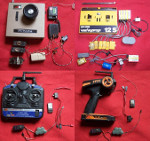Electron power plants

Long before the “ecologist” frenzy invaded our lives, long before Toyota even had the idea of their Prius, radio-controlled models already used electric power for years.
From the very first electric RC model, the question of "batteries" raised for powering our models. This question is not new since the first mass-produced electric RC car hit the market back in 1965: it was the Porsche 904 made by Hegi (Germany). Before that, electric-powered radio-controlled toys already existed: they were generally made in metal, they were also very scale-realistic (like the truck below) and very expensive, but they were not made "to race".
- Details
Radio, Transmitter and Remote
 All these words describe about the same object: the one that allows us to remotely control our models. In this guide, I will use the word Transmitter, as Radio is is commonly used for broadcasts and Remote to control devices such as the TV
All these words describe about the same object: the one that allows us to remotely control our models. In this guide, I will use the word Transmitter, as Radio is is commonly used for broadcasts and Remote to control devices such as the TV ![]() . Whatever you want to call it, this is what this RC Tech Guide is all about.
. Whatever you want to call it, this is what this RC Tech Guide is all about.
So here, we are going to talk about stick radios, pistol radios, trigger and so on... those things we need to control our RC models.
These devices evolved a lot over time, that's why we will start with a short historical reminder that may take you much further in the past than you would expect. Next, we'll talk about the different frequencies before we review the main functions of a transmitter and how to use them.
- Details
Electronic and mechanical speed controllers, motors
 From their debuts, electric RC models are facing a problem: either their energy source supplies all its voltage or not a single electron comes out. In short, batteries (both dry and rechargeable) are either "on" or "off": 7.2V or 0V. This is why different techniques have been used to make the voltage vary between the battery and the motor, so the speed of our models can be controlled. What used to be rather simple at the beginning has now become extremely complex. To be more specific, understanding how modern electronic components work is way beyond what the vast majority of us can apprehend, but at the opposite, they probably never were so easy to use.
From their debuts, electric RC models are facing a problem: either their energy source supplies all its voltage or not a single electron comes out. In short, batteries (both dry and rechargeable) are either "on" or "off": 7.2V or 0V. This is why different techniques have been used to make the voltage vary between the battery and the motor, so the speed of our models can be controlled. What used to be rather simple at the beginning has now become extremely complex. To be more specific, understanding how modern electronic components work is way beyond what the vast majority of us can apprehend, but at the opposite, they probably never were so easy to use.
The purpose of this article is to briefly overview the history of these components and then to basically explain how they work.
- Details
Read more: Electronic speed controllers, ESC, Mechanical Speed Controllers, MSC, motors
Why ball bearings?
 That's right, why? Why so many people recommend to replace plastic or metal bearings included in kits with ball bearings? If they were so important, how come they are not in every kit box? Some manufacturers include them, others don't or not for all their models. Here like so often, the main reason is cost-related: not that a ball bearing set is that expensive, but it saves a few euros on the final kit price. On the other hand, 15 to 30 years ago for the first models, the price was just prohibitive.
That's right, why? Why so many people recommend to replace plastic or metal bearings included in kits with ball bearings? If they were so important, how come they are not in every kit box? Some manufacturers include them, others don't or not for all their models. Here like so often, the main reason is cost-related: not that a ball bearing set is that expensive, but it saves a few euros on the final kit price. On the other hand, 15 to 30 years ago for the first models, the price was just prohibitive.
- Details




